Quieting the Global Growl
Underwater noise from ships has gotten louder, reshaping marine ecosystems and the lives of animals that depend on sounds to eat, mate, and navigate. Can ships ever pipe down?
Article body copy
The following is an adapted excerpt from writer and former Hakai Magazine editor Amorina Kingdon’s new book, Sing Like Fish: How Sound Rules Life Under Water.
It’s late September, and autumn colors flush the forested slopes of Quebec’s Laurentian Mountains. Sun dapples the two-lane blacktop that winds above Canada’s brilliant blue St. Lawrence River. The St. Lawrence is a marine highway that links Toronto, Cleveland, Chicago, Thunder Bay, and other ports along the Great Lakes to the Atlantic Ocean. It’s a waterway where cargo ships, vehicle carriers, and cruise ships run alongside recreational boats.
I’ve followed the river northeast past the neon riot of Montreal and the historic grandeur of Quebec City to the village of Tadoussac. Here, the river widens, shading into the Gulf and the salty Atlantic beyond, just where the smaller Saguenay River reaches the St. Lawrence’s northern bank. Fjord, river, and sea meet in a restive churn that stirs up a rich food web. In summer, whales from 13 species mingle below. Minke whales, blue and fin whales, humpbacks, and dolphins ply the waters.
At the Pointe-Noire headland, a network of walkways and viewing platforms zigzags through maples, evergreens, and golden birch trees many meters above the water. Tadoussac offers scientists fruitful research sites alongside impressive whale watching, and a wooden placard at the walkway entrance makes it clear that belugas are the local celebrities.

The Pointe-Noire Interpretation and Observation Centre, near the village Tadoussac in Quebec, is a whale-watching and research hotspot. Photo by Adrien Le Toux/Alamy Stock Photo
Most belugas live in icy Arctic waters. As the last ice age ended, a handful lingered in the St. Lawrence estuary instead of following the cold water north. Now their descendants are the world’s southernmost, cut off from the rest of their kind. Quebec fishermen once decimated them by hunting them for sport, their white hides fetching CAN $15 each. Today their numbers have rebounded slightly to around 900.
A beluga surfaces below the platform, then dives into the sapphire water. Its white form shades to teal to royal blue as it vanishes in the depth.
As our local guide speaks, I move closer to hear her clearly, in part because of the wind, in part because a cruise ship is approaching from the St. Lawrence.
All afternoon we’ve watched vehicle carriers, cargo ships laden with ore and grain, and container ships moving cars, iPads, and other consumer goods as they pass. The Saguenay also draws tourists, particularly during fall, so cruise ships and pleasure craft abound.
The Saguenay-St. Lawrence Marine Park limits how close commercial and recreational vessels can come to whales. Ships must stay 400 meters away. If a whale comes closer, boats must slow until the whale leaves. Whale-watching boats can get a special license to creep within 100 meters of most whale species, or 200 meters of belugas or blue whales, the two endangered locals. These protections exist to protect whales from the noise that vessels emit.
“Noise” is a technical term. It isn’t defined by volume or source, but rather as unwanted sound that interferes with an important acoustic signal. Sound travels four and a half times faster underwater than in air, and the right sound under the right conditions can cross seas. For many aquatic animals, while other senses—sight, taste, smell, touch—are often diminished in water, sound becomes enhanced. Just as animals evolved to live in certain temperatures, or to eat certain foods, they also evolved in what may be called certain soundscapes. In recent decades, however, these soundscapes have begun to change.
Globally, shipping noise in the ocean has doubled every decade from 1960 to 2010. Piercing sonar, thudding seismic air guns for geological imaging, bangs from pile drivers, buzzing motorboats, and shipping’s broadband growl can also disrupt natural soundscapes. Such human sounds are not universally problematic, but they become noise when they’re unwanted. And while noise can cause acute injury and even death in marine mammals—for example, by sending animals fleeing to the surface from great depths too quickly—it also impacts communication, mating, fighting, migrating, and bonding in subtle and wide-ranging ways. Underwater, acoustic space is valuable, and noise is a trespass.
For the past year or so, I’ve been building a file about how sound works underwater, how marine animals and ecosystems use sound, and how scientists and other people are learning more about underwater acoustics. I’ve talked with scientists, artists, engineers, and others working in this realm, and have learned that while noise is sometimes an animal’s largest threat, it more often compounds with others, such as climate change or pollution. Here in the St. Lawrence River, I want to better understand what this looks like for the whale species—and what we might do about it.
Our guide has to pause. The cruise ship is too loud. It’s four stories of engine noise. It’s so big that as we stand on the slope we look across at its decks, not down, as the beluga dives. Up, down. The ship passes up the fjord, taking its noise slowly upriver.
The Saguenay’s mouth is one kilometer wide. The beluga was swimming just off a flanking headland. Therefore, the ship passed 500 meters from the beluga. Perfectly legal, with room to spare. But … is that really what 500 meters looks like? If the beluga was under for a few minutes, would the ship have seen it, let alone stopped? How could anyone actually track the belugas underwater?
Previously I had trouble linking the concepts of sound and physical harm. I can picture other threats like ship strikes or oil spills. But this is the moment I first realize the acoustic power of noise. The beluga has been down a while. Is it scared? Stunned? I see its white form surface, breathe. It keeps diving. Up, down.
Unless you live near a port or work in the industry, you may not give maritime ships much thought. Shipping is an opaque industry. The vessels that carry 80 or 90 percent of global trade do so far out in the ocean, or near restricted ports and docks. In Vancouver, British Columbia, orange gantry cranes at the Vanterm and Centerm container docks rear their giant heads above downtown, and freighters moor in English Bay like a herd of great iron cattle, but that’s as close as most people get. My home for the past decade, Victoria, British Columbia, lacks container docks, but we do face the Juan de Fuca Strait, a major lane for every ship bound for the ports of Vancouver, Seattle, or Tacoma. Often, four or five ships are in view, distant and small-seeming as toys.
In 1980 the world’s merchant shipping fleet (meaning all ships, not just containers) numbered just under 700,000. In 2020, it’s more than two million. Globally, container ships—with their colorful, Lego-like boxes—make up only about 10 percent of commercial ships. The rest are vehicle carriers, cruise ships, oil tankers, or bulk carriers toting ore, coal, grain, or other commodities.
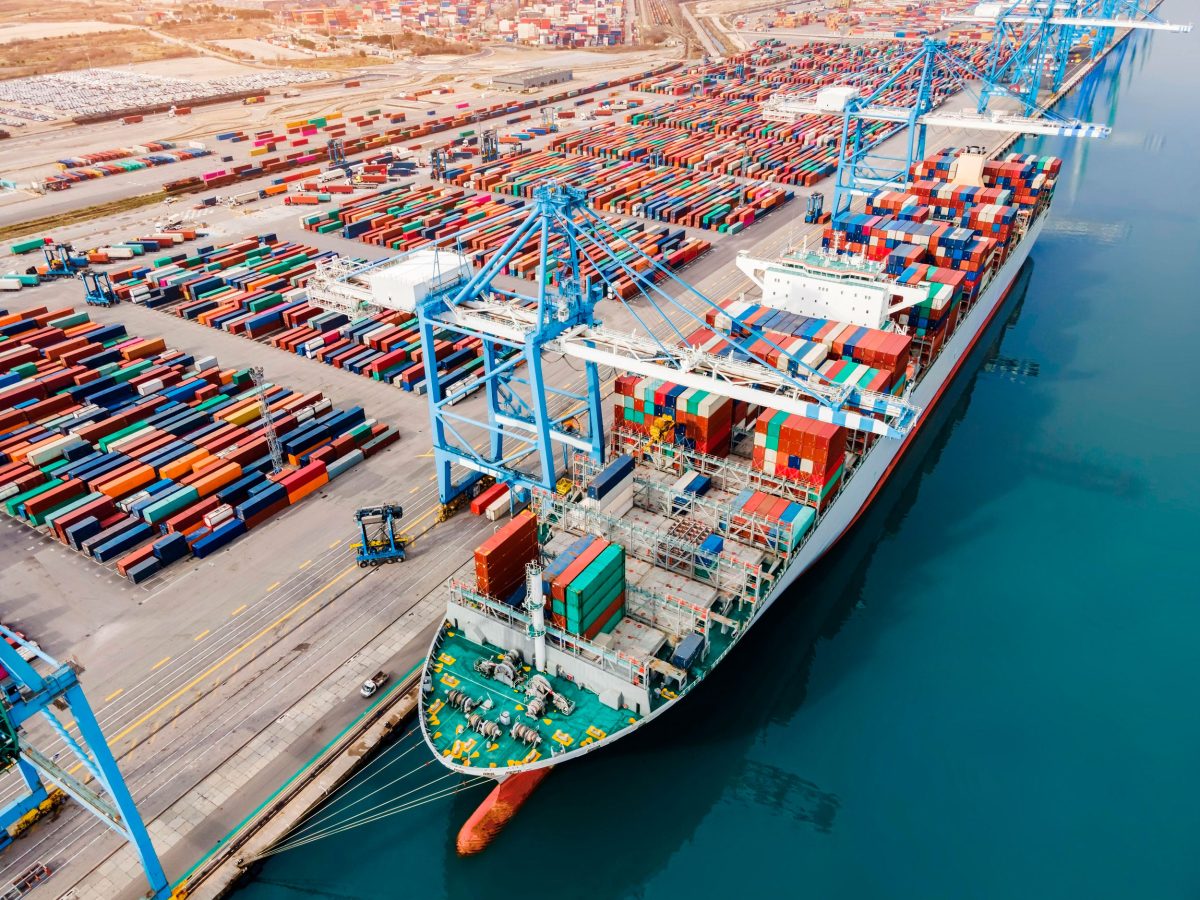
In 1980 the world’s merchant shipping fleet numbered just under 700,000. By 2020, it had grown to more than two million. Photo by NicoElNino/Alamy Stock Photo
Container ships nonetheless carry about half of the world’s cargo, thanks to economies of scale. Containerized cargo moved the global shipping industry to efficient standardized “twenty-foot equivalent units” (TEU), or a 20-foot-long corrugated metal container. These containers let us ship more goods around the world than ever before. We all rely on them, yet most people rarely see these containers and ships.
In January 2022 the container ship SM Busan (6,622 TEU capacity) docked at Ogden Point in Victoria for emergency repairs after losing power in the Pacific. I leaped at the rare chance to see a giant vessel up-close. Its great stern towered above the dock, so high that falling from its back railing would be deadly. Walls of blue and red and green containers were stacked six high and 16 across—more than double the height of the stern. Busan is 304 meters long—as long as 10 large blue whales. And yet as container ships go, she isn’t large. Hundreds carry more than 10,000 TEU. Eighty have more than 20,000 TEU capacity and add another hundred meters to SM Busan’s length.
Between 1992 and 2012, global shipping traffic increased fourfold. The Panama and Suez Canals cut weeks off lengthy trips. Ships that can’t fit in these canals trundle across the Pacific, from Long Beach and Los Angeles, Seattle and Tacoma, to Busan and Shanghai, in lanes like the Juan de Fuca Strait as technologies like GPS and an ever-pinging automatic identification system (AIS) track them 24/7.
Of course, they make noise. Standing on the deck of a ship, the loudest sound you hear might be the growl of the engines. Yet beneath the water, ship noise comes primarily from the propeller—specifically, from bubbles that form on the prop’s edge in a process called cavitation.
As a propeller spins, the blade’s leading edge presses the water, creating high pressure, and the trailing edge of the blade follows with very low pressure. We know that water boils at lower temperatures as ambient pressure decreases. On a ship’s propeller, pressure drops at the trailing edge, flash-boiling the seawater, and bubbles form. They collapse on the blade or trail off into the water. At the same time, hydrodynamics at the root of the blades makes the prop hub trail another line of bubbles called the hub vortex.
Invisible below the water, Busan’s propeller is several meters across. The largest container-ship props can be nine meters. These propellers shed bubbles that flash-boil seawater and oscillate, the vibration becoming a sound. Bubbles vary in size, so collectively they make many frequencies, most in the low hundreds of hertz. Ship noise, then, is broadband, with most of the energy in lower tones.
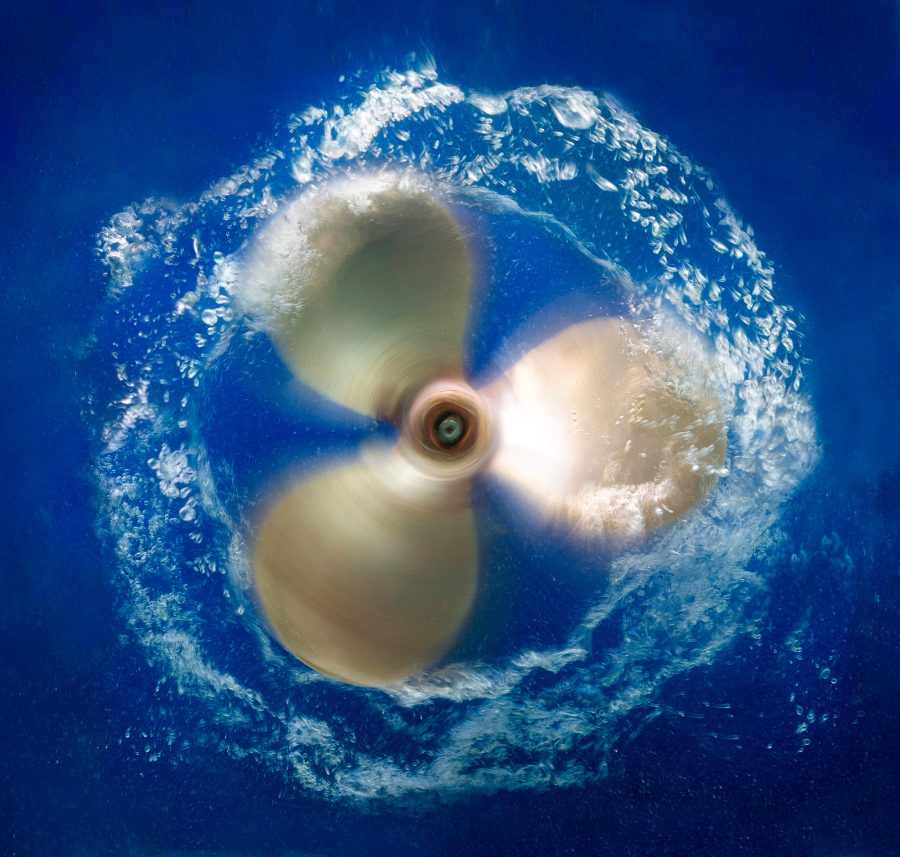
Much of the underwater noise from ships comes from propellers, or more specifically, from bubbles that form on the propeller’s edges. Photo by Horizon International Images/Alamy Stock Photo
Ship sound isn’t necessarily deafening. It’s more of a chronic background drone, like living near a highway. It might influence an animal’s behavior or communication, making an animal move to where it wasn’t going to go—or interrupting an animal’s echolocating, singing, or vocalizing.
Most animals are far enough from a ship that its noise will merely reduce the animals’ listening and communication space. Listening space is the space within which an animal can hear signals. This is often thought of as a sphere, but if the sound is directional, the shape of the listening space can change depending on whether the animal is facing it.
Communication space, conversely, is the distance over which the animal can meaningfully receive and decipher signals from others. Both listening and communication space can shrink from a noise that falls in an animal’s hearing range. For mammals, if a noise occurs at, or contains, the same frequency as an important sound like another whale’s call, this target sound can be masked: the animal can’t pick out the original signal from the noise.
An earthquake, or a hurricane, can do this. A shipping lane, like a highway, also shrinks this sphere. As for invertebrate animals that can’t move away—like scallops or mussels or seagrass or polychaete worms that live beneath marine highways—chronic, long-term noise can mimic short, intense noise. Loud ship noise can be like working in a factory for decades.
Faced with chronic ship noise, animals respond in one of a few ways. In some cases, mammals can compensate and increase their hearing sensitivity to certain sounds. The animal can also move somewhere quieter. Or it can call in a different frequency, call louder, repeat itself, or stop calling altogether. These strategies come with costs. Sometimes the costs are negligible. Sometimes not.
Take, for example, killer whales living in the Salish Sea that have been affixed with D-tags, data-collecting devices the size of a small paperback, with suction cups that attach to a whale’s smooth skin. A skilled person standing in a boat holding a long pole with the tag on the end taps the tag on a whale when it surfaces. The tag travels with the whale for a while, then releases and floats to the surface, where boats zero in on its GPS signal. Once retrieved, the D-tag provides audio, GPS location, and acceleration: the story of a whale’s movement, the sounds it made, and the sounds it heard.
Killer whale salmon-hunting dives have a unique profile. The whales swim near the surface, making slow clicks, then dive down in the depths, corkscrewing and twisting, chasing the fish, their clicks shading into terminal buzzes that precede capture. When they approach their prey, they suddenly accelerate, or jerk, and roll to one side. They chomp down, and debris often floats to the surface as the satiated whale zips back upward to find its family and share its catch.
Thanks to AIS data, the location and speed of commercial vessels is largely public and includes that of whale-watching boats, recreational boats, and other vessels around British Columbia’s Gulf Islands, where the southern resident killer whales come to eat salmon through the summer and fall. The AIS data and D-tag data together tell a tale.
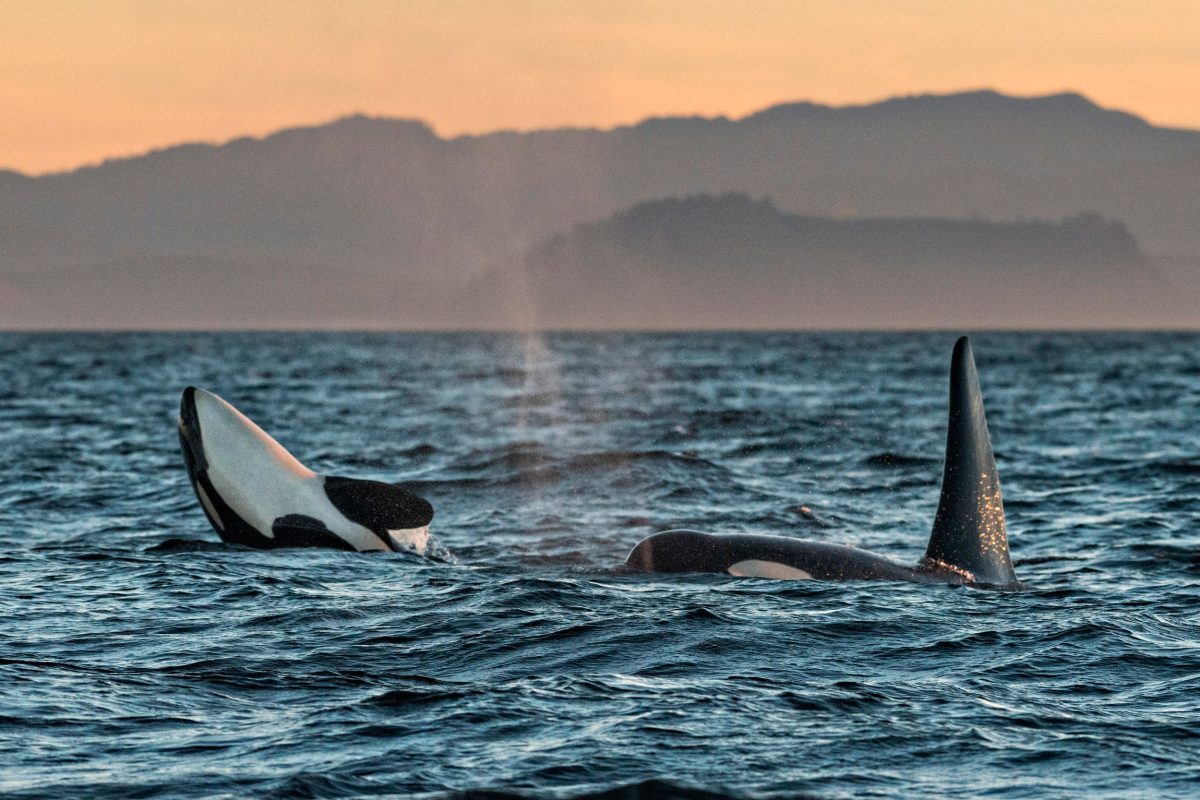
Data from southern resident killer whales in British Columbia shows that the presence of ships impacts the cetaceans’ hunting behavior and success. Photo by Richard Ellis/Alamy Stock Photo
When vessels were closer than one and a half kilometers, the whales dove faster but caught fewer fish. Of course, it’s impossible to ask a whale exactly why it responded this way, whether it was noise or simply the vessel’s presence that affected them. However, most small vessels have echo sounders that ping above human hearing but right at the peak frequency of a killer whale’s echolocation click. When vessels used their echo sounders, nearby whales dove slower and stayed down longer.
When there were noisy vessels nearby, the whales made more of the slow and searching surface clicks. The females in particular made fewer buzzes, suggesting they didn’t make as many chases and captures. The males, however, dove for longer. Preliminary estimates show that for every decibel of increased noise underwater, the whales buzzed 21 percent less. The boats are well within local regulation, but for an endangered animal that eats one type of food, vessel noise has caloric consequences. Simply put, whales are expending more energy and eating less around boats.
A similar drama plays out in the waters off Denmark, where Baltic harbor porpoises echolocate for fish amid the busy shipping lanes feeding the North Sea, Baltic Sea, and Kattegat Strait. Suction-cup tags tracked seven porpoises foraging for four days around ships, and how their behavior changed. The porpoises spent about 59 percent of the time foraging, and the porpoise in the quietest waters heard ships rumbling 17 percent of the time. The porpoise in the loudest area was bombarded by noise a whopping 83 percent of the time. When the noise edged over about 100 decibels, the animals buzzed less often. During one pass of a ferry, a porpoise stopped foraging while the ferry was still seven kilometers away, waiting 15 minutes before it began to hunt again.
Maybe the porpoises are adapted to these busy waters. But maybe they have no choice but to try and hunt, despite the noise, if their prey congregates in hotspots. Porpoises’ metabolic needs are high. If they are interrupted 12 times a day for six minutes, that’s a real energy cost.
Some populations of harbor porpoise are thriving, but others are not. In the inner Baltic Sea swim some 500 animals, an isolated and dwindling population. An already stressed or sick animal cannot afford to lose time, or calories, to ships.
If sound expands the world, then noise shrinks it and takes it away. What’s an animal to do in noisy waters when it needs not only to listen but also to communicate over distance?
Valeria Vergara, now a senior scientist with British Columbia’s Raincoast Conservation Foundation, came to Tadoussac in the summer of 2017. She was watching a calving ground—safe and sheltered waters where beluga mothers come to give birth and nurse their newborns. Twenty-two kilometers up the river from the mouth of the deep, narrow Saguenay, the Sainte-Marguerite River creates a shallow delta where mothers hang out with their calves, eating, resting, chilling—and calling.
Vergara and her colleagues had previously estimated the sound levels of rudimentary calls made by a newborn beluga at 120 decibels, about 22 decibels quieter than adults or subadults. If this data—gathered from a newborn and adults at the Valencia Oceanographic Aquarium in Spain and four wild belugas in the St. Lawrence—translates to all belugas, then other belugas potentially hear their faint newborn calls up to only about 350 meters away, while adults have a communication range of up to 6.5 kilometers.

Data on the sound levels of beluga whale calls gathered from the Valencia Oceanographic Aquarium in Spain could shed light on how boat noise affects the ability of wild belugas to communicate. Photo by David Stock/Alamy Stock Photo
Vergara spent 23 days several meters above the water on a makeshift metal observation tower set up onshore, counting boat and beluga sightings while simultaneously recording noise levels in the water with a hydrophone. She found boat noise halved the contact-call range. A baby whale bleating into boat traffic could be heard over less than 200 meters, and an adult less than three kilometers. And that was only for hearing the call. Picking out the call type, its details and nuances? For animals whose vocalizations may include dialects and identification calls—animals whose calls have a range of frequencies, probably important information, even identification information—the reduction in space could be even greater, since another beluga not only needs to hear the call but also to understand it.
Then there was the effort of “shouting” back. In the early 1900s, a French doctor named Étienne Lombard identified an effect that bears his name. The Lombard effect happens in humans, birds, and marine mammals when there’s background noise. We vocalize louder to be heard over the din. In the early 2000s, biology student Peter Scheifele found that the St. Lawrence belugas did this around boat noise. Given my own sore throat after singing along to a live concert, I can imagine this effort can be taxing.
There seems to be an obvious fix to noise as a pollutant: just be quieter. That’s a seductively easy-sounding idea. Of all the ways to hush a ship, there are three big ones: physically separate ships and animals by shifting shipping lanes and setting up warning systems, slow down, or design a quieter ship. Simple, right? As a project done by shipping giant Maersk demonstrates, the last is not always straightforward when it comes to the biggest boats on the planet.
Globally, the Danish firm A. P. Moller-Maersk operates some 700 vessels. It was the world’s largest container-ship company from 1996 until 2022, when it was surpassed by the Mediterranean Shipping Company. In the mid-2000s, Maersk formed a working group with some other carriers and their clients to think about how to increase their efficiency. The cost of fuel was high, and some of Maersk’s customers were global brands like Nordstrom and Ikea that were growing worried about public backlash for their shipping carbon footprint. For slightly different reasons, Maersk and its clients both wanted efficiency. They studied how to optimize their networks, since container ships run on set schedules and routes, and they ordered new vessels with efficiency upgrades.
A container ship’s life is 20 to 25 years. If the company waited for new builds to incorporate designs, the fleet wouldn’t be fully upgraded for decades. So, Maersk undertook a project it dubbed the “radical retrofit,” which would give some of its huge container ships a makeover. “We decided to retrofit certain of our vessels that were, sort of, teenagers,” says Lee Kindberg, North American head of environment and sustainability at Maersk. “They still had lots of life in them.” Every five years, a ship gets dry-docked, repainted, cleaned, and given upgrades or repairs to keep it in working order. Why not make them more efficient while they were at it?
Maersk retrofitted 100 of its ships over the course of five years. Twelve of these were “G-class” ships (all with Danish names beginning with G—Gunhilde, Gertrude, Georg). For example, Gudrun (built in 2005, retrofitted in 2015) will likely operate for another 10 years. Each G-class vessel is 367 meters long, 43 meters wide, with a draft of almost 16 meters.
“Yeah,” Kindberg says fondly. “They’re big girls.”
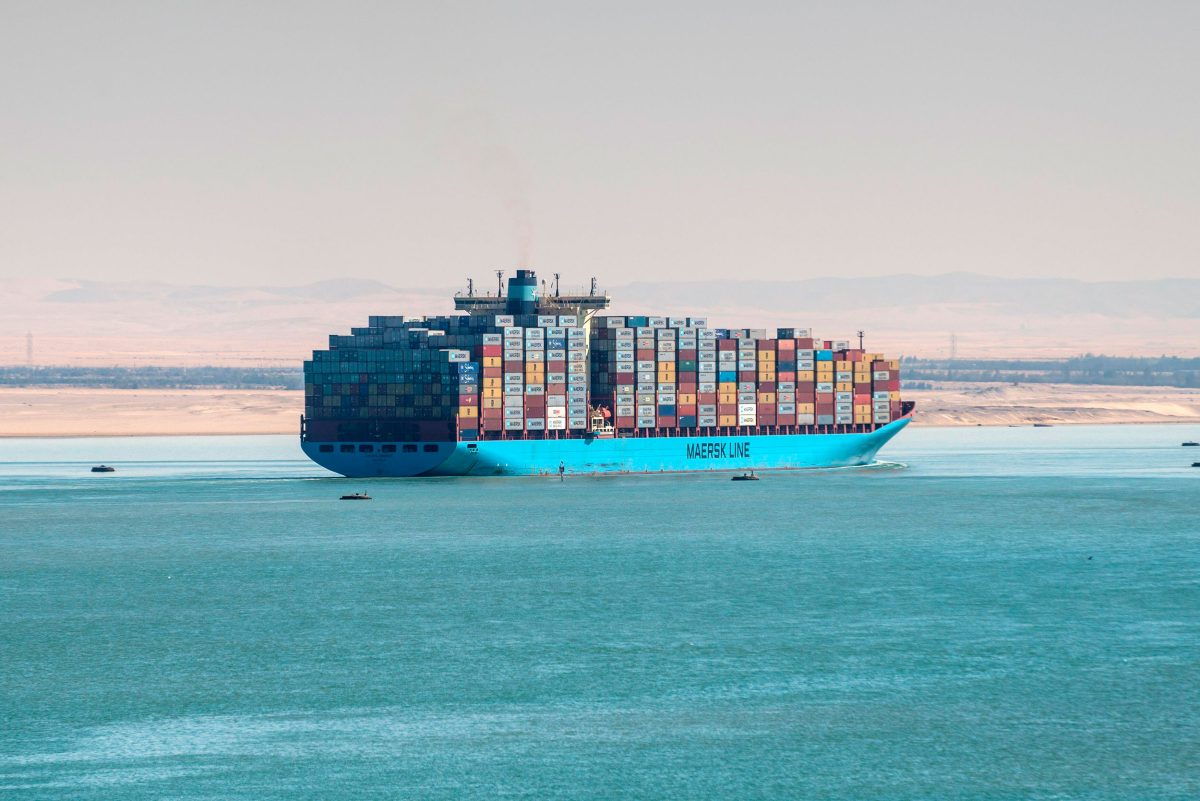
A cargo ship operated by the global shipping giant A. P. Moller-Maersk passes Egypt’s Suez Canal. Photo by Panther Media GmbH/Alamy Stock Photo
Each vessel is also an immensely complicated system of moving parts, and changes to one thing—say, the propeller—affects trim, which has knock-on effects on efficiency. Bow and hull shape affect wash along the hull. Considering that dry-docking something the size of an apartment building is very expensive and cuts into the ship’s working life, only a comprehensive suite of carefully integrated changes is remotely cost-effective.
At the outset, noise considerations weren’t part of the retrofit. But at the time, Kindberg was starting to work with a unique initiative in Vancouver called the Enhancing Cetacean Habitat and Observation, or ECHO, program, which tried to reduce shipping noise in the southern resident killer whale territory by asking ships to voluntarily slow down in certain areas of the Salish Sea. Because of this, Kindberg wondered if the more efficient ships might also be quieter post-retrofit. For ships, as for any other machines, sound and noise are lost energy.
“Any time you have noise happening, it means you’re not being as efficient as you can be,” says Kindberg. It made sense that a more efficient ship would be quieter. Specifically, the retrofit had outfitted the “girls” with more efficient propellers, traditionally the loudest part of the ship. These new propellers reduced noisy cavitation.
For a large ship, one of the most common propeller upgrades is a boss cap fin. It looks like a tiny second propeller, mounted on the hub of the main prop, and it reduces the hub vortex to almost nothing. Designers can also change the angle or the number of blades, improving efficiency and reducing cavitation. Shipbuilders like to avoid cavitation, regardless of noise. Each bubble that forms along the prop can pit the steel and reduce its efficiency.
To discover if the new props were quieter, Kindberg needed to listen to her spruced-up fleet in action. “You’d think that [noise] would be something that would be routinely measured during sea trials,” she says, “but there really aren’t a lot of facilities around the world where you can go and have it measured in a standardized way.”
In fact, measuring noise from a container ship, just like retrofitting itself, is a surprisingly complex undertaking. Should it be measured from the front, where it’s quiet? The back, where it’s loud? Directly beneath? To the side? You can’t just put a hydrophone in the water and hit record. So, the noise-reduction question remained open until a fortuitous conversation. “A woman at the Vancouver Aquarium,” Kindberg recalls, “mentioned to me that John Hildebrand at [the Scripps Institution of Oceanography at the University of California San Diego] had a lot of data on underwater noise.”
Hildebrand’s lab monitors a suite of underwater hydrophones called HARPs off California, including one lying in 580 meters of water beside the outbound shipping lane from the Port of Los Angeles and the Port of Long Beach. These two ports sit side by side just south of LA and are the biggest container ports on the continent, the North American gateway to Asian consumer goods like clothing, couches, and iPhones. This makes the Santa Barbara Channel a superhighway, where ships start their two-and-a-half-week jaunt across the Pacific.
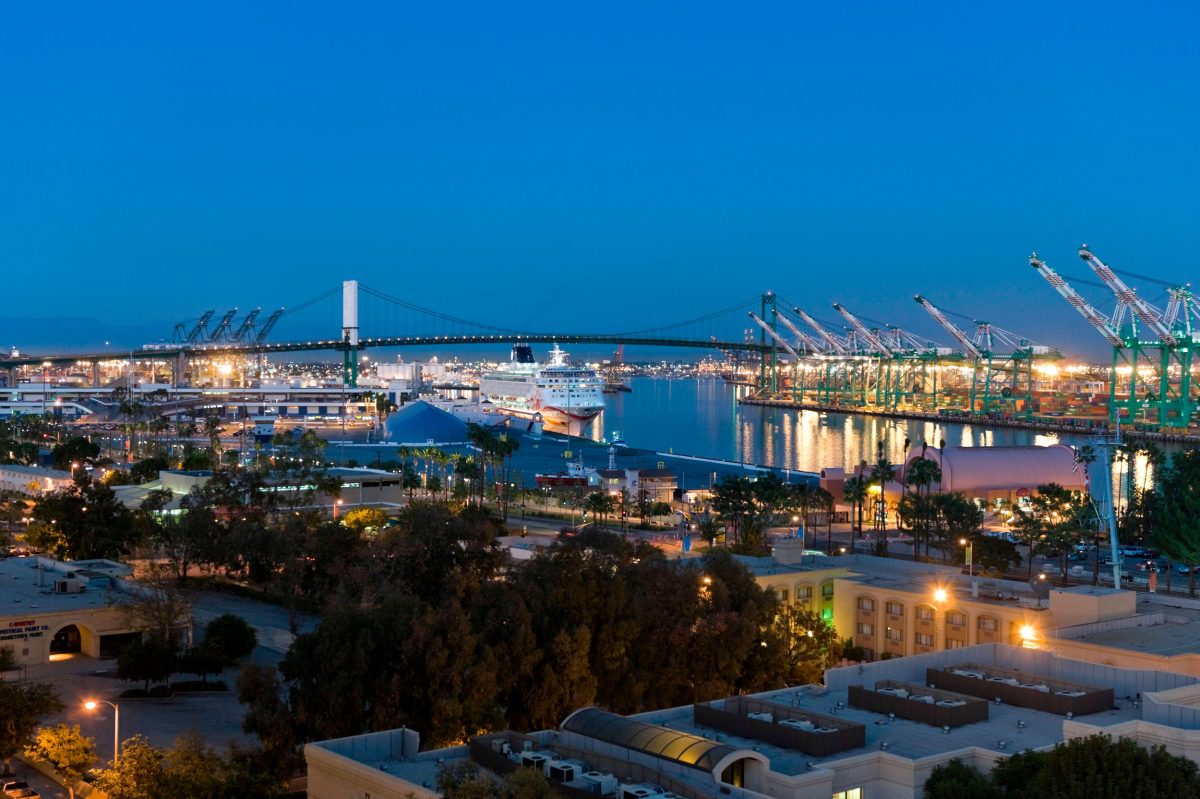
The Port of Los Angeles is one of North America’s largest, serving as a gateway for Asian consumer goods like clothing, couches, and iPhones. Photo by Ian Dagnall/Alamy Stock Photo
Kindberg knew her G-class vessels were workhorses on the Pacific routes. (Their retrofits included shore power, a technology that lets ships turn off their engines at a dock and plug into a shore-based power source, reducing emissions near coastal areas. It’s cost-effective to keep a ship on routes that have this option, which many Pacific ports do.) Gudrun, Gertrude, and their sisters spent their days crisscrossing the Pacific. “And I realize that at least one of these vessels calls at LA—Long Beach. And [Hildebrand] had, like, 10 years of data.” So Kindberg asked to combine his recordings with the AIS data pinpointing the passage of the G-class ships, and then compare their sounds before and after the retrofit.
Many things changed in the retrofit, so they measured two frequency bands—from eight to 100 hertz, and from 100 to 1,000 hertz. Lower-frequency changes came mostly from propeller changes. Higher-frequency changes came mostly from the engine and machinery tweaks.
The preliminary data showed that post-retrofit, the source levels of container ships were six decibels quieter in the low-frequency band. The data was only for five ships, and it wasn’t peer-reviewed, but it was the only real-world data of its kind. Then a few years later, Vanessa ZoBell, a PhD student of Hildebrand’s, crunched the numbers for the other G-class transits.
The source levels of the 12 ships were five decibels quieter post-retrofit, in the low-frequency band. Yet the radiated noise, the noise measured at the hydrophone, was louder post-retrofit, by almost a full decibel. As with everything else in naval architecture, it’s complicated.
ZoBell explains that the ships were now carrying an additional 1,100 containers each, sinking them deeper in the water and increasing their draft. This increased draft then changed how propeller sound moved outward, thanks to something called a Lloyd’s Mirror effect, caused by sound interference at the sea surface.
“So basically,” she says, “since the source is close to the surface, [some sound] rays will bounce off the sea surface and reflect downward.” This reflection then destructively interferes with other sound waves, and they cancel each other out. It’s a bit like noise-canceling headphones, whose built-in microphones create opposing sound waves to create silence. After correcting for this, thanks to complicated math, there was less noise at the sound source, but more radiated noise overall.
As if that weren’t complex enough, sound spreads out from ships completely differently in deep water (about 150 meters or more) versus shallow water. It’s such a critical difference that the International Organization for Standardization has one set of standards for measuring sound in deep water but is drafting different standards for doing so in shallow water.
Ship noise is a mutable thing, depending on the ship’s condition, its propeller, its engine, its draft, its tonnage, the reflection of the sound off the surface, and whether it’s in deep or shallow water. So tweaking ships to make them quieter is not as simple as it sounds.
When dealing with economies of scale, cargo can get quieter and greener per tonne, per TEU, per unit. But with more cargo overall, the noise will still increase. Kindberg says that Maersk has reduced greenhouse gases per tonne shipped by more than 50 percent, and if ZoBell’s numbers are indicative, retrofitted ships actually create fewer decibels per TEU. But the size of the ship and volume of goods make up that difference.
There is another level of noise reduction here: larger ships make fewer trips. But what this means for animals isn’t clear. “So now they’re carrying more, so potentially, less transits required,” ZoBell says. “But what’s important to a whale? Less transits? Or more transits, but quieter?”
So what about another strategy: slowing down?
Haro Strait, a major channel just to the east of Canada’s Vancouver Island, is a whale-watching hotspot and a dog-leg shipping route that sees around 14 ships pass through each day—on a busy day, more than 20. Haro Strait’s island- and shoal-studded convolutions are hazardous enough that all ships require a professional pilot trained in navigating it.
Before any ships enter Haro, they pause on Constance Bank south of Victoria. Bright-yellow boats zoom out to deliver or pick up pilots, who aid the ship’s navigation between there and Vancouver. The job is so difficult that pilots train for decades. If you stand on the seawall and squint, sometimes you can see the pilots climbing from the yellow boats up onto the great ships on a ladder slung over the side.
Ships and whales have long had an uneasy coexistence in these waters. Concerns about cetaceans, particularly the endangered southern resident killer whales, have risen sharply in recent years as contentious proposed pipeline and port expansions have promised even more vessel traffic. In 2014, the Vancouver Fraser Port Authority led the ECHO program to try and reduce the cumulative effects of shipping on whales in the area, primarily noise. And one of the only ways to make ships quieter is by slowing them down. By 2017, ECHO was ready for a trial.

A container ship traverses Haro Strait, east of Vancouver Island, British Columbia. A pioneering initiative to slow down ships in Haro Strait has led to a 24 percent reduction in the intensity of underwater sound. Photo by Bill Gozansky/Alamy Stock Photo
From August 7 to October 6 of that year, pilots heading out to the commercial ships gave them the option of slowing down to a target speed of 11 knots as they set out through Haro Strait. Several hundred ships, or 61 percent of commercial vessels that passed through the Strait, participated. Of those that did, 44 percent of all commercial vessel transits managed to get under 12 knots—55 percent under 13.
For a bulker or cargo ship, that was about two knots slower than normal, and about 5.9 decibels quieter at the source level. For a large container vessel, that was up to 7.7 knots slower than normal, and reduced sound source levels by around 11.5 decibels. As for the received sound levels, or what an animal might hear, hydrophones near Haro Strait detected a reduction of 1.2 decibels during the slowdown, or about a 24 percent reduction in sound intensity.
Slowing down has some costs. As Kindberg describes, container ships run on schedule, like a bus route. Delays at sea or in port make carriers noncompetitive. Then there’s safety. Sometimes it’s dangerous to slow down in high currents or bad weather. Finally, the slower a ship goes, the longer it’s in an area. That might translate to more cumulative noise, more greenhouse gases, and other toxic emissions nearshore. If a ship is in poor maintenance, then staying longer in the area won’t be quieter and could make things worse, though by listening in real time, such ships can be identified and their owners notified.
On balance, a slower ship is quieter and the 2017 slowdown trial estimates that slower speeds can reduce the amount of time noise interrupts killer whale feeding by about 10 percent. Participation rates in recent years have been over 80 percent, and the program has expanded its slowdown areas and even shifted the shipping lane along a stretch of the route into Haro Strait.
Kindberg likes the ECHO program. It’s an opportunity to make her fleet a little less intrusive to the ocean, and the connectedness of modern ships means that she gets up-to-the-minute reports from each ship on speed, fuel efficiency, position, and other metrics when ECHO reports how well “her” Maersk ships did in Haro Strait. It’s like a video game, with Kindberg aiming for a “perfect” month of speed reductions.
Yet, while a few similar programs elsewhere are slowly ramping up, speed remains the norm in most shipping lanes.
The last major strategy to reduce ship noise impact is to physically separate ships from animals—or, at least, to do so in the (largely coastal) areas that are both important to the animals and bustling with traffic. This has happened in a few places, but as with other attempts to mitigate underwater noise, it’s easier said than done.
The Kattegat Strait in Denmark is a shipping lane that sees some 80,000 ships each year from the North Sea into Baltic ports. In 2020, Sweden and Denmark decided to shift the shipping lane. Scientists took advantage of this and measured noise on the old and new lanes. The Kattegat is home to the Baltic harbor porpoise, a population of which is endangered, and there were concerns about the impacts of noise on the porpoises’ echolocation and feeding abilities. When the numbers were crunched, the waters around the old lanes were found to be slightly quieter as traffic dwindled. But the new lanes were louder, and the problem had only shifted.
It’s worth noting that this natural experiment wasn’t designed for the porpoises, however. Where shipping lanes run through an animal’s hunting or breeding grounds, the noise reduction in those areas from moving the lane might make a significant difference.
On a smaller scale, many places have regulations about how close boats can get to whales. Back in Quebec on that bright fall day, I go whale watching. It’s my first glimpse of baleen whales, and I’m thrilled to see the flukes of a humpback sliding gracefully out of the water as it dives. Smaller minkes pop up everywhere. But privately, I’m most excited at the sleek back of a fin whale. I’ve grown deeply affectionate toward these second-biggest cetaceans with their monotonous seismic song.
The Saguenay-St. Lawrence Marine Park regulates how close ships and recreational boats can come to whales. From my perspective on the water, the 200 meters that our whale-watching boats are allowed seems, if not completely unobtrusive, at least polite. But our little 20-foot-long open motorboat is soon dwarfed by a three-story vessel with a large deck, and a voice blares through a speaker loud enough that I hear every word. Most of this noise reflects off the surface, sure. But the boat shadows us for much of the trip.
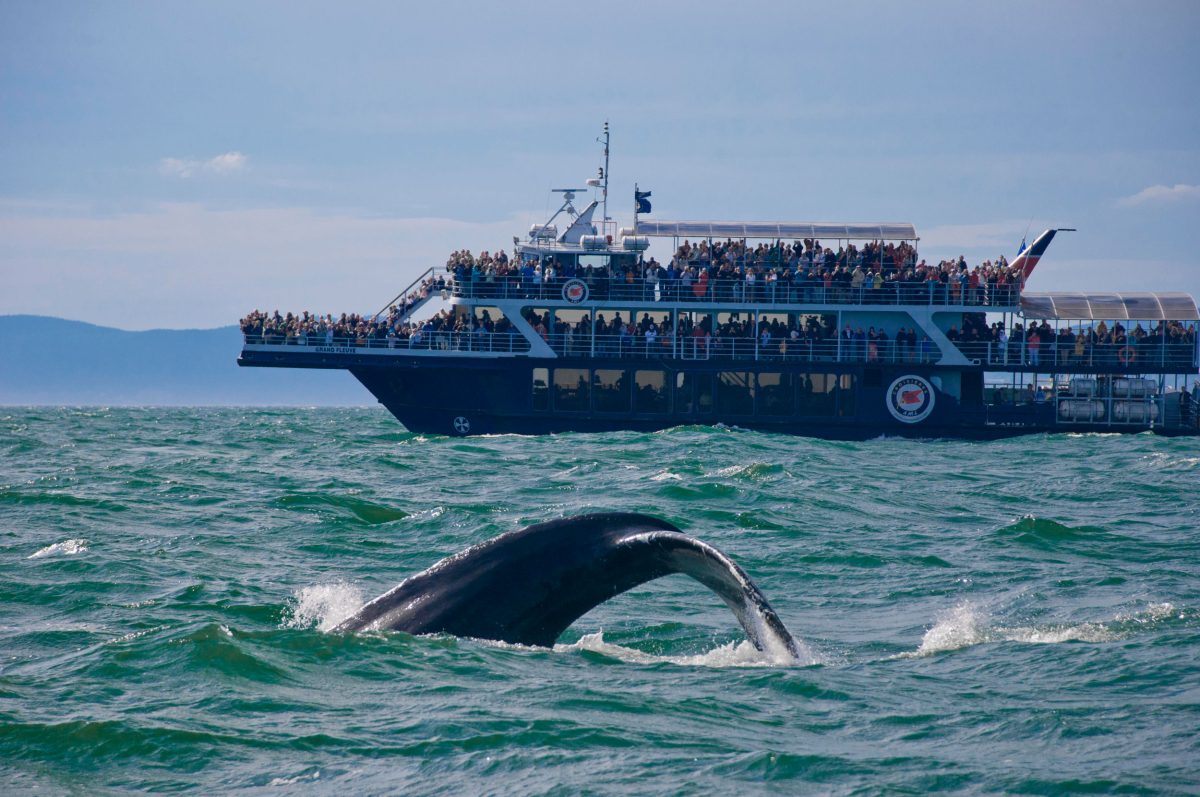
Tourists flock to Tadoussac, Quebec, to glimpse some of the 13 whale species that live in the nearby waters. Photo by AGF Srl/Alamy Stock Photo
Our noisy boats have, curiously, isolated us from whales in a strange way. Engine noise drowns out the sounds that fishers, boaters, or other ocean travelers might otherwise hear from whales above the waves or through the hull. In a 1950 paper accompanying the first underwater St. Lawrence beluga recordings, the authors note, “Arctic voyagers … have heard some of these underwater calls under favorable conditions of quiet as the animals swam under their vessels; sometimes the hull, acting as a resonator, amplified these sounds, especially in the past, before engines and generators made even idle ships noisy.”
The perspective was echoed by Roger Payne and Scott McVay in their 1971 paper: “During the quiet age of sail, under conditions of exceptional calm and proximity, whalers were occasionally able to hear the sounds of whales transmitted faintly through a wooden hull. In this noisy century, the widespread use of propeller-driven ships and continuously running shipboard generators has made this a rare occurrence.”
As we discover more about the sounds animals make underwater and the impact we have on them, the impetus grows to find a solution to noise. Slowdowns, lane shifts, retrofits, and research on a wider range of species are all good starts. But shutting up is not easy. Will humans step up and decide to be considerate marine neighbors in the coming critical years, or let this window of opportunity pass? The lives of our underwater neighbors may depend on it.
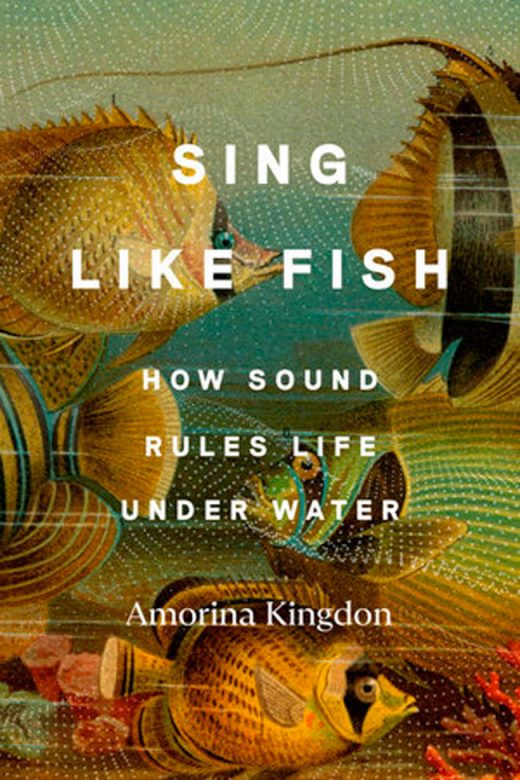 Adapted from the book Sing Like Fish: How Sound Rules Life Under Water by Amorina Kingdon. Copyright © 2024 by Amorina Kingdon. Published by Crown, an imprint of the Crown Publishing Group, a division of Penguin Random House LLC.
Adapted from the book Sing Like Fish: How Sound Rules Life Under Water by Amorina Kingdon. Copyright © 2024 by Amorina Kingdon. Published by Crown, an imprint of the Crown Publishing Group, a division of Penguin Random House LLC.



